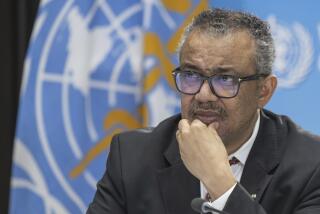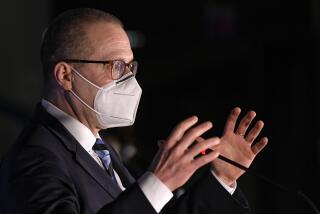WHO will urge most countries to stop H1N1 testing
- Share via
As the World Health Organization prepares to recommend that most countries assume that their flu cases are the result of the novel H1N1 swine flu virus, officials are seeing the first signs of resistance to the commonly used antiviral drug Tamiflu -- though so far none that are particularly disturbing.
Meanwhile, the virus is continuing to spread through the Northern Hemisphere this summer -- even though flu normally doesn’t spread well in hot weather -- and its effect is growing in the southern half of the globe, which has begun its traditional winter flu season.
Within the next few days, the WHO will suggest that countries with major outbreaks of swine flu move away from laboratory confirmation of cases and toward larger, national indicators of disease, such as the number of people with flu-like symptoms and cases of pneumonia, Dr. Keiji Fukuda, WHO assistant director-general, said Tuesday in a telephone news conference.
The large number of cases in such countries is overwhelming labs and making it “very hard to keep up” with testing, he said. The new guidelines will “ease the burden on laboratories,” he said. In most countries with major outbreaks of the virus, 95% or more of total flu cases are being caused by H1N1.
“In countries with no cases, we will continue to recommend that people be tested so the presence of the new virus can be confirmed,” Fukuda said. “In all countries, we will continue to stress testing for unusual cases, clusters, unusually severe cases and new symptoms.”
But the number of swine-flu-free countries is likely to be small soon. The most recent figures reported to the WHO indicate that more than 98,000 cases have been confirmed in 120 countries, with 440 deaths, though officials estimate the number of actual infections at 10 to 100 times that.
The most recent figures for the United States indicate 33,902 lab-confirmed cases and 170 deaths, but officials at the national Centers for Disease Control and Prevention have estimated that more than 1 million Americans have contracted the virus.
In the last two weeks, health officials have identified three patients -- one each in Denmark, Japan and Hong Kong -- with a virus resistant to Tamiflu, known generically as oseltamivir.
The cases in Denmark and Japan occurred in patients who had been taking the drug prophylactically; the Hong Kong case involved a girl who had traveled from San Francisco and never been given oseltamivir, suggesting that she contracted a resistant virus.
Viruses from all three patients displayed the same mutation producing the resistance, and officials believe it is a spontaneous mutation, not a recombination with seasonal viruses, many of which are resistant to the drug.
All three viruses were susceptible to the antiviral drug Relenza, known generically as zanamivir.
The WHO is not particularly concerned about the mutations, Fukuda said, because there is no evidence that the resistant virus is spreading.
“The single most important point, at this time, is that we are not recommending any clinical changes to . . . treating patients,” he said.
The health agency continues to recommend prophylactic treatment for those exposed to people with a known case of H1N1.
Unlike seasonal flu viruses, the H1N1 virus is continuing to spread largely unabated during the Northern Hemisphere summer.
Outside the United States and Mexico, the greatest spread has been in Britain. Last week, that country’s health minister said he expected 100,000 new cases every day for the foreseeable future.
The virus is also spreading throughout the Southern Hemisphere, where the flu season is just beginning. Hardest hit is Argentina, with 2,800 confirmed cases and a death toll that doubled in the last week to 60, the third-highest toll after the United States and Mexico. Chile has had more than 8,000 confirmed cases and 18 deaths. Australia has had more than 6,300 confirmed cases and 13 deaths.
So far, however, the virus does not appear to be changing, and the number of deaths is apparently a reflection of the widespread nature of the disease.
Africa has been the last continent to see an outbreak, and the virus’ presence has now been confirmed in 12 countries there, Fukuda said.
The continued spread of the virus to developing countries will severely tax the United Nations, which will need more than $1 billion this year alone to combat the pandemic, Secretary-General Ban Ki-moon said Monday.
He said the agency has not been receiving as much money for the pandemic as it had hoped.
--
More to Read
Sign up for Essential California
The most important California stories and recommendations in your inbox every morning.
You may occasionally receive promotional content from the Los Angeles Times.












